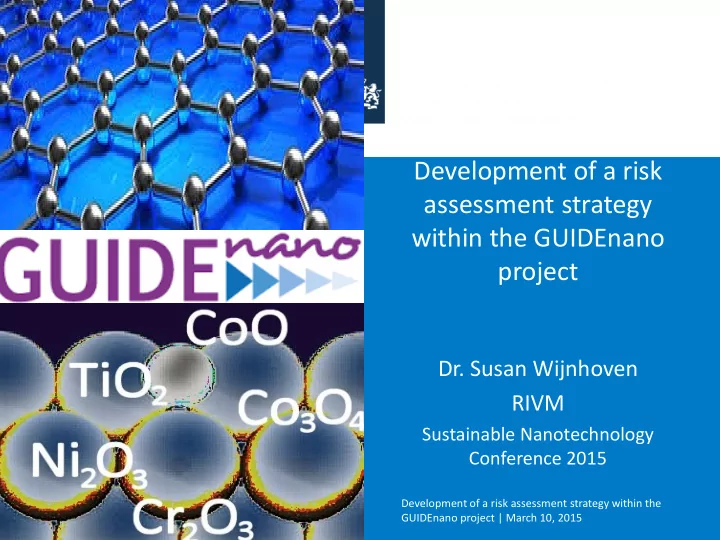

Development of a risk assessment strategy within the GUIDEnano project Dr. Susan Wijnhoven RIVM Sustainable Nanotechnology Conference 2015 Development of a risk assessment strategy within the GUIDEnano project | March 10, 2015
Project Consortium Universities & Research Centers Industry 2
Main Goal Develop innovative methodologies to evaluate and manage human and environmental health risks of NM-enabled products, considering the whole product life cycle Interactive digital Guidance Tool 3
Target and scope SCOPE OF THE GUIDANCE THE TARGET NM-enabled product Life Cycle Risk Assessment Release/Exposure Impact Assessment evaluation in NM-enabled product Target manufacturing Organisms Environmental Fate NM Nano-enabled Refine RA production Use product X Risk Management Recycling RISKS End-of-life Safer-by-design NO acceptable? Exposure control YES Waste Management No further action required: NM-enabled product considered safe 4
Organization in WPs WP1 Management WP1 Management WP9 WP9 Development of Development of WP3 WP3 WP4 WP4 WP2 Scientific Coordination WP2 Scientific Coordination the the Release Release Exposure Exposure GUIDEnanoTool GUIDEnanoTool WP7 WP7 Risk Risk Assessment Assessment WP5 WP5 WP6 WP6 WP10 WP10 Fate Fate Hazard Hazard Testing of Testing of GUIDEnano Tool GUIDEnano Tool in real case- in real case- WP8 WP8 Risk reduction and management Risk reduction and management studies studies WP11 Dissemination, Standardization and IPR WP11 Dissemination, Standardization and IPR 5
Project Timeline GUIDEnano Project Experts Experts (GUIDEnano hypothesis-driven experiments (State-of-the-art knowledge) + new data from other projects) Structure and Validation & Refinement main input data GUIDEnano Tool.v1 GUIDEnano Tool.v2 GUIDEnano Tool.v3 Validation & Refinement Validation & Refinement Experts Industrial partners (8 case-studies) (selected case-studies) Stakeholders (representing the interests of Industry, Regulators, Insurance, Consumers) 6
The Tool Release to relevant Environmental fate environmental / modelling Default human Activity Decision tree compartments cards Model Exposure levels and NM form in relevant environmental / human compartments WoE / Prioritization Hazard endpoints Read-across algorithm values NMs Read-across Toxicity studies Relevance / Quality available to the user score 7
Risk assessment Decrease risk by RMM/ safe by design
Risk assessment • Risk assessment decision flow: – Divided in 4 main elements • Input and information requirements (exposure and hazard assessment) • Risk assessment (calculation of risk and classification into 3 categories) • Recommendation for follow-up actions (reduction of uncertainty, risk mitigation) • Output report GUIDEnano SCM Meeting – Leiden, 16 th -17 th September 2014
Risk assessment
Information requirements ‘Risk characterisation ratio’ (RCR): • Exposure: – relevant exposure routes/ duration – model output, exposure libraries, direct measurement data • Hazard: – relevant endpoints with (if possible) quantitative exposure estimate with uncertainty
Hazard endpoints • Identification of human hazard endpoints to be addressed for each exposure scenario Quantitative ? route duration endpoints to be evaluated Endpoints N inhalation single 1,3,4,6, 7 1 Irritation/corrosion N repeated 1,2,3,5,6,7,8 2 sensitisation dermal single 1,3,4,6, 7 3 absorption/accumulation/elimination Y Y repeated 1,2,3,5,6,7,8 4 acute toxicity Y oral single 1,3,4,6,7 5 repeated dose toxicity N repeated 1,2,3,5,6,7,8 6 mutagenicity N/Y 7 carcinogenicity 8 reproductive and developmental toxicity Y
Risk assessment qualitative endpoints Yes/No answer with uncertainty value Exposure YES NO Low Medium High Low Medium High Hazard uncertaint Uncertaint uncertaint uncertaint Uncertaint uncertaint y y y y y y Low Risk No Risk uncertaint y Medium YES No Risk Uncertaint y High No Risk uncertaint y Uncertainty Ratio Y/N Low No Risk No Risk No Risk No Risk No Risk No Risk uncertaint Low 70-90 / 10-30 y Medium Medium 50-70 / 30-50 NO No Risk Uncertaint y High 50/50 High No Risk uncertaint y
Risk assessment quantitative endpoints Exposure = certain amount per time in mass/ time or surface area/ time or number of particles/ time Hazard = lowest exposure level at which an adverse event can be expected (‘DNEL’, default, PNEC )
What risk is “ acceptable ”? ~5% chance of risk Relatively high chance of high exposure level ? 50% chance of risk >95% chance of risk RCR = Exposure / Hazard
Risk assessment quantitative endpoints Change from acceptable to “probability of risk” Defaults: Acceptable risk, low probability of risk : <5% probability on a ratio of > 1. Possible risk, medium probability of risk: 5-75% probability on a ratio of > 1. Unacceptable risk, high probability of risk: >75% probability on a ratio of > 1
Follow up actions Possible risk: reduction of risk or reduction of uncertainty
Follow up actions Unacceptable risk: reduction of risk
Future work: risk assessment • Continue with tool development • Discuss and review definition of (acceptable) risk • Further development of uncertainty/ sensitivity analysis • Definition of content of output report • Stakeholder analysis of tool • Validation with case studies
Acknowlegdements • GUIDEnano project consortium – All partners • Gemma Janer (LEITAT) • Socorro Vazquez (LEITAT) • Margriet Park (RIVM) • Ralph Vanhauten (TW) • Lion Traas (TW) – WP7 • Petra van Kesteren (RIVM) • Maria Luisa Cruz- Fernandez (INIA) • Derk Brouwer (TNO) • Thies Oosterwijk (TNO) • Joost Westerhout (TNO) • Manoj Vaghela (Pinsent Masons)
What is uncertainty? Measured data can be summarized with an average value and standard deviation. This is the variance in the data. Extrapolation of the data (e.g. from one scenario to the next, or from animals to humans) will introduce uncertainty . Model estimation of parameter values will also introduce uncertainty . SCENARIO Introduced level of IDENTICAL COMPARABLE DIFFERENT uncertainty IDENTICAL None Low High SUBSTANCE COMPARABLE Medium Medium/High High/Very high DIFFERENT High High/Very high Very high What is considered as “high” uncertainty? A 10 -fold deviation? Or a 1000-fold deviation? The level of uncertainty needs to be quantifiable. Uncertainty Average ± variance Uncertainty when defining the appropriate reference scenario
Recommend
More recommend